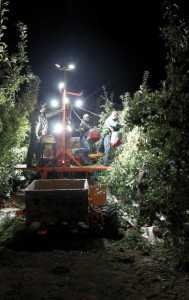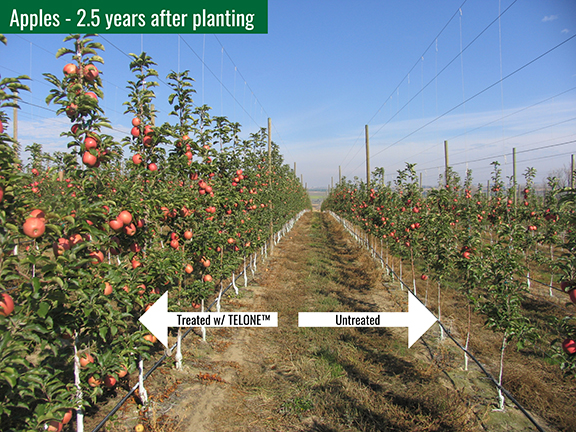Is Nighttime The Right Time For Harvest?
 Yes, it is! The winegrape industry has already figured out the answer to the question above. What could be more appropriate than a bottle of Pacific Northwest wine and a plate full of tasty specialty crop products enjoyed under the autumn moonlight?
Yes, it is! The winegrape industry has already figured out the answer to the question above. What could be more appropriate than a bottle of Pacific Northwest wine and a plate full of tasty specialty crop products enjoyed under the autumn moonlight?
However, is nighttime the right time for other activities? Again, yes … but maybe not what you are thinking.
In fact, many vineyard activities now occur purposefully at night and directly enhance the production of higher quality grapes. It takes more than moonlight, of course. Fluorescent or LED lights are mounted on mechanical harvesters or specialized movable towers for traditional hand-harvested blocks.
This strategy is not uncommon among table grape, sweet corn, and melon growers, for a variety of considerations related both to the workforce and the crop plant. Perhaps most compelling, field workers can operate under more comfortable conditions than those during hot, sunny days. This is hugely significant, given the danger of heat-related stress on the workforce and the necessary but costly preventative measures growers have in place.
Same as humans, crop plants can be greatly damaged by temperature and light stress. Nighttime harvest can provide fruit that retains significantly better internal and external quality: sugars, acids, flavor compounds, color, firmness, etc. Even the mechanical act of separating fruit from stem or pruning can be easier at night, when the crop plant and its parts are less stressed.
Overall productivity increases based on a longer workday/night. The feasibility of two shifts per day is enhanced by the more comfortable conditions. Individuals working another job have an opportunity to add to their income.
Finally, in vineyard and orchard blocks where a multiple pick process based on fruit physiological maturity is practiced, the brighter and more even illumination provided by high-quality artificial lighting (especially LED sources) can improve the picker’s ability to discriminate mature from immature fruit, resulting in a much higher quality product. This is a clear advantage in crops like winegrapes, apples, and cherries, where the demands of the enologist or produce retailer are high and getting higher.
Proving The Concept
Why, then, have Pacific Northwest tree fruit growers pretty much ignored this approach, while many of the region’s grape producers are using it routinely? Receiving and packing operations at tree fruit warehouses regularly operate throughout the night and picking often starts in the dark of the early morning. Orchardists are no strangers to all-night vigils during frost protection season.
Especially for vineyard blocks in which bunches are picked by hand and destined for premium wines, higher returns can justify the additional expense and management. But even in blocks where the grapes are utilized for wines with lower price points, nighttime operations are common and possibly profitable only because harvest in this case may be a once-over, mechanized process.
Perhaps this is where tree fruit producers can find a sweet spot. Platforms and/or mechanical assist harvest equipment utilizing supplemental lighting might just make nighttime operations attractive enough for producers to make the leap and benefit from the potential human and crop advantages.
 I was fortunate enough recently to see exactly that kind of leap. Led by Karen Lewis of Washington State University and Ines Hanrahan of the Washington Tree Fruit Research Commission, a group of us were able to see three mechanical assist machines in nighttime operation at Green Acre Farms in White Swan, WA.
I was fortunate enough recently to see exactly that kind of leap. Led by Karen Lewis of Washington State University and Ines Hanrahan of the Washington Tree Fruit Research Commission, a group of us were able to see three mechanical assist machines in nighttime operation at Green Acre Farms in White Swan, WA.
Owner Jim Morford and his manager, Mike Van Pelt, have been running these three machines for this apple harvest. Each has several hundred hours of service, with occasional mechanical issues, but nothing that can’t be fixed using a crescent wrench and off-the-shelf components.
That reliability and ease of repair is precisely what J.J. Dagorret had in mind when his company, Automated Ag Systems of Moses Lake, WA, commercialized his design this crop season. Previously, Dagorret had worked in California and Florida, where his Bin Bandit is a well-regarded unit deployed in tree fruit, tree nuts, citrus, and vegetables.
Dagorret has already sold five units of his latest creation, called the Bandit Xpress, to growers in the Pacific Northwest. The units we saw operating at Green Acres fit nicely into the high-density vertical trellis apple block. Four crew members moved ahead of the machine on the ground, picking into conventional bags and depositing fruit into bins previously laid out in the drive row.
On the platform itself, four crew members handled fruit in the top of the canopy, picking into conventional bags and depositing their fruit into a bin elevated into the platform. The driver ensured quality control and kept the machine moving briskly along. All pickers were kept busy and bin swaps were accomplished with little down time.
The quality of the pick was impressive. The supplemental LED illumination actually helped discriminate immature or damaged fruit, and the platform workers, tethered to an overhead bar for safety, moved easily along the canopy. Crews using the platforms for either day or night shifts were able to work for 11 hours and indicated less fatigue than an eight-hour day doing ladder work. The noise level was low, permitting the blasting of the crews’ preferred motivational music.
Workers on the harvest crews at Green Acres arrived with no experience whatsoever picking apples. Interestingly, despite their lack of experience and the fact they were in a color pick block, Morford estimated their bin per day production easily matched his expectations while meeting his quality standards.
This particular platform, like the half-dozen others currently being tried in the Pacific Northwest, are best suited for high-density blocks, ideally with a narrow canopy fruiting wall. Not all are equipped for nighttime operations, although that is a relatively easy modification.
Clearly, this is not the magic solution to the labor challenges tree fruit growers confront across the country. Still, there is a chance we might learn something from progressive winegrape growers, who have widely adopted intensively managed, high-density systems and so often lead the way horticulturally.
Maybe this nighttime activity and mechanical assist is something we should adopt more widely. And perhaps we could substitute a bottle of Pacific Northwest cider for that bottle of wine to celebrate!










